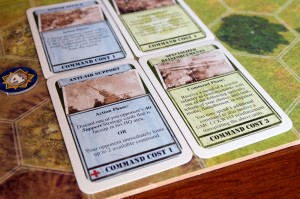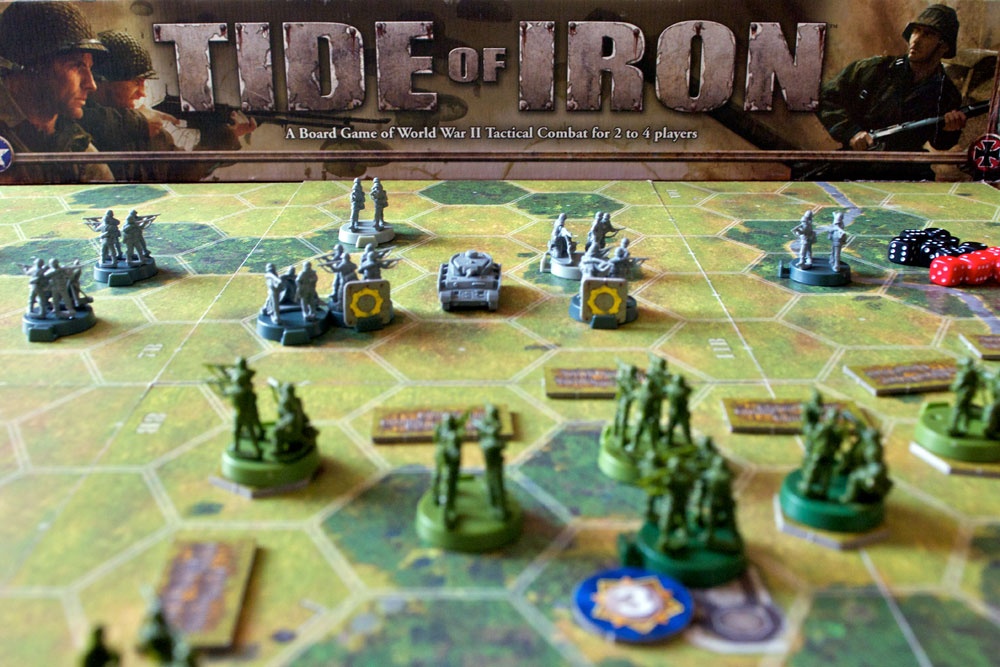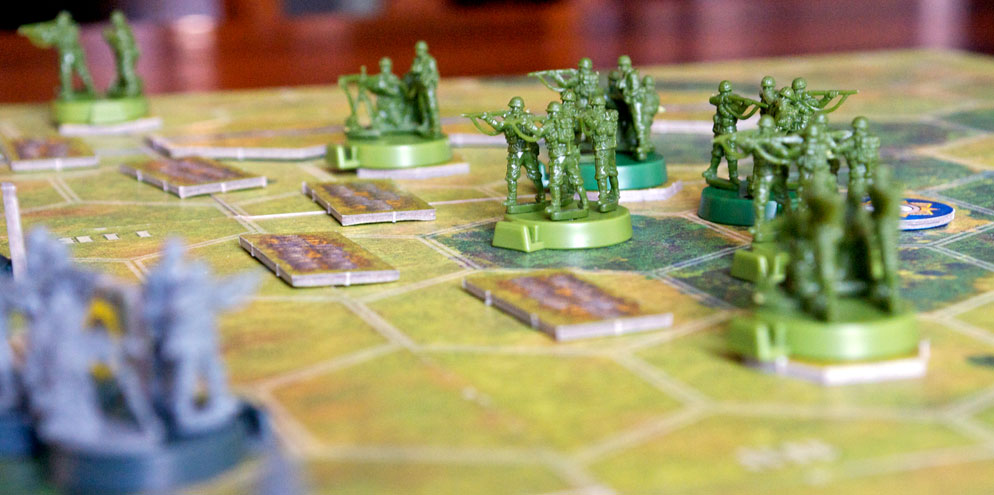 When I started writing reviews for Board Game Quest, one of the unexpected outcomes would be the diversification of my gaming experiences. In the early days, I had played most of the standard pillars of the gaming world, but never ventured outside that comfort zone.
When I started writing reviews for Board Game Quest, one of the unexpected outcomes would be the diversification of my gaming experiences. In the early days, I had played most of the standard pillars of the gaming world, but never ventured outside that comfort zone.
One area I have had very little exposure to is the world is tactical war gaming. My only experience with this genre is when I reviewed the iOS game Drive on Moscow. I admit, I was awful at the game at the start; however, I quickly learned from my mistakes and enjoyed the tactical nature of the game. I decided that I needed to try out a tabletop war game to see if the experienced transferred.
Today, we will be looking at Tide of Iron. The game is a modular war game set in World War II that was originally released by Fantasy Flight games back in 2007, and recently licensed to 1A Games to produce the second edition of the game; Tide of Iron: Next Wave and future expansions. I have had the chance to play with both versions of the game and will give my thoughts on the two versions in addition to our normal review. I have a lot to cover so let’s get to it!
Tide of Iron is a modular war game for 2-4 players to play in around 2 hours. In my experience the game plays best with 2 or 4 players.
Game Overview:
Set in the years of 1944 and 1945, players will take charge of American or German forces to simulate battles during this time. Tide of Iron is a scenario-based game where each game will have a specific map, number of rounds, objectives and troops. At the start of each scenario, players will choose how to place their troops into squad bases and place them on the board. Each scenario gives players a specific number of actions they can take each round to move and attack with these squads. By controlling certain spots, players will gain command tokens that they can use gain the initiative for the next round, or spend to activate strategy cards that can turn the battle in their favor. The game will continue until the number of rounds in the scenario or the necessary win conditions for a player are met.
Components:

As a game that was once made by Fantasy Flight, the components are top-notch. All of the tokens, miniatures, maps tiles and cards were of the highest quality in the original release and this continues in the new version of the game. In terms of quantity of components, this game fits a lot of plastic and cardboard in the box. The game comes packed with over 500 pieces and is one of the heftier games on my gaming shelf!
There are two changes with Tide of Iron: Next Wave that I want to mention here. First, the box size has been decreased to a standard size. This is a welcomed improvement over the large “coffin box” from the first edition. The second has to do with changes to the rulebook. The first thing they did was separate the rulebook into three sections. They also separated how to play and advanced rules into different books. While the core rules are the same as the original game, 1A Games decided to take a different approach to presenting the rules to the players. They have included introductory scenarios to inaugurate players to the rules and mechanics in the game. This removes the intimidation of the other 50+ pages of rules and scenarios in the box.
How to Play:
With the lengthy rule book that I just mentioned, I will not be going over every detail about how to play the game. I’m going to give a basic explanation of the how the game works, but if you want to look at more detailed rules, download the full rule books here.
At the start of the game, players choose which scenario they are going to play. This will determine the units each player gets, what map tiles to use, starting locations, sets of strategy cards, winning conditions, and many other important aspects of the game. After the board is set up, players will place their units into bases and are allowed to group their troops in whatever fashion they choose. These squads are then placed into the designated deployment zone. Once this lengthy setup is complete, the game rounds can begin.
Each round is divided into three phases:

1. Action Phase
This is the main portion of the game. Each player will have a set number of actions they can complete during this phase. The player with initiative takes all of their actions first, followed by their opponent. Each action can be any one of the following:
- Advance a squad a number of hexes up to their movement points
- A unit immediately makes a Concentrated Attack on an enemy
- Place a unit in Op Fire mode to attack when they are in range on an enemy unit
- Allow a troop to move and make an attack (Fire and Movement)
- Players can Activate a Strategy Card to give them an advantage
- Make and Assault attack, allowing a unit to move and attack an adjacent hex
- Put a unit into Fatigue and can’t act the rest of the round
- Take a Special Action
2. Command Phase
This phase allows players to make strategic decisions involved with the scenario. By having control over certain hexes on the map will earn players command and victory points. Command tokens can be used to activate strategy cards or used to gain initiative for the next round.
3. Status Phase
While under a different name, this phase is essentially a clean up phase for the next round. At the start of the phase, players will draw one strategy card into their hand. Then will then remove any tokens that were placed during the last round. Each player will be able to assign players in Op Fire mode and transfer units between squad bases in the same hex. Finally, any scenario reinforcement or events that activate this round will occur and the round marker will move up one.
I want to describe how combat works in Tide of Iron, since it is a major mechanic in the game. When a player attacks with a squad they must first determine the total attack strength for the attackers and the defense for the target unit. The attacking player will declare a normal attack or a suppressive attack which disrupts the effectiveness of the enemy squad for that round. The attacking player will roll attack and defense die to determine hits on the enemy unit. The range of the attack will dictate what numbers are needed on the die to make a successful hit. Any defense dice that are five or better negate a successful hit. Players will take a casualty, removing a figure from the squad, for each hit.
Play will continue until the rounds for the scenario are complete or a victory condition has been met by one of the players.

Game Experience:
I’m not going to lie, Tide of Iron is an intimidating game for someone who doesn’t play a lot of tactical war games. It’s ridiculous number of components and massive rulebook could easily turn people away from playing this game. I admit, I was one of those people at the start. After reading the first few pages of the original edition’s rulebook, my head was spinning. I soldiered on and have read through the rulebook more times than I have read the Hobbit. I’m glad to report that my long journey to understanding how to play this game was worth the effort.
The systems used in Tide of Iron are remarkably elegant. Sure it has lots of rules to learn like line of sight, unit movement, and others that by just the volume of them could end up making the game a jumbled mess. In reality, they all work as you think they should and thus making them easy to learn. Sometimes in games, you find a rule that frankly doesn’t make a lot of sense to theme or seems just odd. You don’t find that here. You will find yourself referencing the rulebook quite a bit during your first few scenarios, but after a while everything becomes second nature.

The action phase gives you plenty of options for your units and each one has its place on the battlefield. The one thing I kept feeling while I was playing was that I never could do enough. While limited actions are not new to tactical games, I felt the weight of each decision more in Tide of Iron than other games. I found myself wanting to play scenarios over and over trying new tactics and methods to see if I could improve. Speaking of scenarios, there are plenty in the rulebook to keep you occupied. Each one has its own unique twist that forces you to adapt in order to win. Plus, there are more scenarios online made by passionate fans for you to try if you want a new challenge.
There are so many mechanics that I could talk about in this game, but there are two that I want to focus on in-depth. The first of these would be the strategy cards. Most scenarios will give you access to one or more strategy card decks. These decks introduce off-board events or extra forces that players can bring onto the battlefield. I like how these cards add just a touch of randomness to the game. Because the card draw is random, players have to adjust to the cards they draw. These cards also introduce another layer of strategic decision-making for the player. Most cards have a cost of a certain amount of command points. These points are used only for these cards and determining who goes first the next round. It is a constant struggle to determine where to spend those command points each round and one that I enjoy.
The second thing I want to talk about is the unit construction element of Tide of Iron. I assumed that this customization would be standard procedure, but after some quick research I found that this isn’t common. I love that this game allows you to add some personality to your units. You are allowed to have two mortar units, a two officers and a machine gun crew, or any other combination that you think will help you win the battle. There are also squad specialization tokens that give these units even more customization like a flame thrower, anti-tank capabilities, and others you can add if the scenario allows. The ability to build your own units is a great thing, I just wish it wasn’t such a pain to do it. Each unit you place in the base requires some force and after placing 20+ figures my fingers started to hurt. Because of the snugness of units in the bases, they are not the easiest to get out when one gets killed.

Whenever a new company takes over an existing game, people sometimes worry. However you shouldn’t with the A1 Games version of Tide of Iron. In fact, I think it’s the better version! The components in the box haven’t changed and retain the same quality as their predecessor. Having the game fit next to my other games easily rather than searching for a place for a massive box is another step in the right direction. The only negative that people could take from Tide of Iron: Next Wave is the rulebook. I mentioned in the component section how they decide to separate the rule book into three sections to ease people into the rules of the game. This is great for new players, but veterans might be annoyed with this change. I admit that as I was searching for a clarification of a rule or two, I wasn’t sure exactly where to find the answer. It’s a little annoying, but not a deal breaker. The biggest improvement to this edition is the introductory scenarios. This allows players to experience the rules as they learn them and speeds up the process. This is something I hope more heavy tactical games incorporate into their rule books.
Very rarely do I enjoy a game that has a team variant in the rulebook, but Tide of Iron is an exception. A four person game is played 2 vs 2 with the troops divided between the players. Each player has complete control over the actions their troops take each round. What I like about playing with four players is that you can focus on half the troops rather than the whole battlefield. Talking to your teammate and deciding basic courses of action makes the game feel like a team effort. I don’t think it is superior to the two player game, but it isn’t worse.
Final Thoughts:

Tide of Iron is everything you want in a tactical war game. It has great components, many scenarios, and solid mechanics that all blend together to create a memorable experience. The new edition by 1A games is true to the original while making some improvements along the way. If the theme and mechanics sounds like something you enjoy, I recommend this game for you.
But therein lies the biggest issue with this game, connecting it to the general board gaming audience. You have to know if you will enjoy a game like Tide of Iron before you buy it. This isn’t a game that you bring to a game night expecting to teach and enjoy in one night. This is one of those campaign type games that is enjoyed playing over and over. If you have enjoyed light war games like Memoir ‘44 and want to take your tactical gaming to the next level, Tide of Iron is that game. I say this because I was in that camp before I played Tide of Iron. I enjoyed the high level of strategy in the game and can’t wait to experience more of it as I continue to play.
If you’d like to get a copy of this war game, you can pick it up for about $67
Final Score: 4.5 Stars – An excellently designed game that if you like the theme and mechanics should find its way into your collection.
 Hits:
Hits:
• Top notch components
• Introductory scenarios ease players into the rules
• Unit customization adds flavor to each squad
• Nice mix of strategy and tactical mechanics
Misses:
• Have to find the right group to play
• Placing and removing units from bases can be difficult























I feel you with placing the units on the bases. I got tired of it myself and decided to fix it by cutting those nubs off and gluing small washers on the bottom. I then took some Litko magnetic flex circles and glued them to the bases. A little work up front makes this so much easier to setup and play, just place the figures. Great review, matches my opinion of the game spot on. This definitely scratches my ASL itch and is easier to find opponents.
Great review! 🙂 Thx for that!
Is it possible to use the 1AGame-Version Rule-/Scenario-Books with the fantasy flight version of the game?
Yes you can engimono.